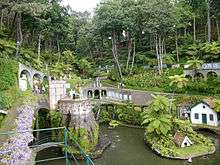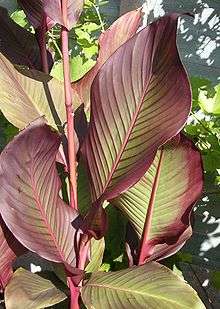Tropical garden
A tropical garden features tropical plants and requires good rainfall or a decent irrigation or sprinkler system for watering. These gardens typically need fertilizer and heavy mulching.

Tropical gardens are no longer exclusive to tropical areas. Many gardeners in cooler climates are adopting the tropical garden design, which is possible through careful choice of plants and flowers. Main features include plants with very large leaves, vegetation that builds in height towards the back of the garden, creating a dense garden. Large plants and small trees hang over the garden, leaving sunlight to hit the ground directly.
Tropical plants
The following are some examples of tropical plants to be used in tropical gardens or as indoor plants.
Hoyas
Hoyas are known as the “Wax Flowers” due to their texture and almost unreal appearance. They need relatively warm and humid conditions, but depending on the specific variety of Hoya, they can endure heavy rainfall for some months during the wet seasons just as they may also be exposed to long dry periods. They are commonly used indoors. They need indirect light, but the amount or required light depends on the variety. They need small amounts of water and the soil is to be kept slightly dry since a very wet soil can end up killing this kind of plant. They can be grown in pots that are not too big or in hanging baskets. They grow better if kept at a minimum temperature of 15 degree Celsius (59 Fahrenheit).[1]
Banana plants
Contrary to common belief, growing banana trees is not that difficult and allow people to enjoy their own bananas.[2] Also these plants can be used as windbreaks. They need fertile soils, large mulch and organic matter, large amounts of nitrogen and potassium, warm temperature, high humidity, large amounts of water, and shelter from other banana plants. Banana plants are not to be exposed to strong winds and extreme weather conditions (too hot or too cold weather) with an ideal temperature being 26-30 degree Celsius (78-86 Fahrenheit). They stop growing below 14 degree Celsius (57 Fahrenheit). Banana rhizomes are planted upright and their roots have to be well covered with soil.[3]
Bird of paradise
Among the many species of birds of paradise is the Strelitzia reginae, an indigenous plant to South Africa and South America. As a tropical plant, it grows in warm, humid climates.[4] This exotic, colorful plant, with evergreen leaves resembles a bird's beak. It is an outdoor plant provided the weather is not too cold. Otherwise, it is better to keep it in a pot indoors. It needs rich soil as well as sun or partial shade. Another requirement for this plant is a good drainage.
Ferns
Ferns are commonly used to give gardens a great foliage. Most ferns are easy to take care of. They basically cannot be exposed to direct sunlight for long periods of time. Moreover, their soil should always be moist. One way to keep ferns moist is by misting them.[5]
Papaya tree
Papaya trees should be planted where they can be kept warm and free from wind and freeze. They need enough water to support their leaves, but it should not be exceed as to a root rod. They also need a well-drained soil.[6]
Orchids
Night temperatures between 12- 18 degree Celsius (55-65 Fahrenheit), and day temperatures between 23-26 degree Celsius (75-80 Fahrenheit) are fine temperatures for orchids. Orchids need sufficient amounts of light as well as humidity. However, there are many varieties of orchids and each of them features specific care needs.[7]
Maintenance
A tropical garden is one of the most difficult gardens to build or maintain, it becomes more difficult the more your local climate differs from the natural habitat of your plants. The keys to a healthy tropical garden are plentiful light and water. The large leaves that feature in tropical plants require the soil to be humid at all times, so irrigation might be a must-have for some gardens. Over-watering causes the roots to rot, killing plants.
A tropical plant that is not cold-hardy should be brought indoors during the winter and returned to the garden for the summer.
Non-tropical climates
Tropical plants that work well in non-tropical climates include;
Gallery

 Double Hibiscus
Double Hibiscus Canna 'Auguste Ferrier'
Canna 'Auguste Ferrier'
Attractions
Many attractions feature tropical gardens, including:
- Alma Park Zoo, Kuranda, Queensland, Australia
- Kuranda Scenic Railway, Dakabin, Queensland
- Colasanti's Tropical Gardens, Kingsville, Ontario, Canada
- Flor og Fjære, Stavanger, Norway
- Cedarvale Botanic Garden and Restaurant, Davis, Oklahoma, USA
- Reiman Gardens, Ames, Iowa
See also
References
- "Hoya Care". Retrieved 2010-06-07.
- "Cheap banana trees". Archived from the original on June 8, 2010. Retrieved 2010-06-07.
- "Growing bananas". Retrieved 2010-06-07.
- "Jungle-Type Bird of Paradise Flowers". Retrieved 2010-06-07.
- "Fern Care". Retrieved 2010-06-07.
- "How Not to Kill Your Papaya Tree". Retrieved 2010-06-07.
- "Orchids – General Care". Retrieved 2010-06-07.
